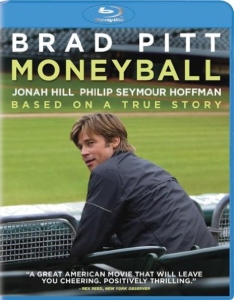“Moneyball” includes so many scenes of Oakland A’s general manager Billy Beane (Brat Pitt) and other baseball people spitting chew into cups that it almost plays like an extended version of that “Naked Gun” riff where even the players’ wives are spitting. It’s as if screenwriters Steven Zaillian and Aaron Sorkin and director Bennett Miller were trying to paint this as a “baseball movie” in the same sense as “The Natural” or “Bull Durham” or “61*.”
It’s not that type of movie, though, and it’s better for it. Interestingly, while “Moneyball” is a movie about the triumph of cold, hard math over gut feelings, it gets a lot of mileage out of being uncomfortable about this. While it makes a strong case that Beane’s philosophy of embracing undervalued statistics to find market inequities changed baseball forever, there’s still romance in “Moneyball.” For example, there had to be a little magic from the Baseball Gods for the A’s to win a ridiculous 20 games in a row in 2002, right?
“Moneyball” brings just enough romance into its non-romantic story. Catcher Scott Hatteberg (Chris Pratt from “Parks & Recreation”) is out of baseball due to nerve damage in his throwing arm when Beane recruits him to play first base. Beane’s embrace of on-base percentage (as opposed to the more limited, but sexier, stat of batting average) is the reason why Hatteberg gets one more shot at baseball, but the “We’ll give you one last shot, kid” sequence could fit in any sports movie.
And there are the clichés: The aforementioned spitting, Beane going to town on a water cooler, and the fact that Beane never watches the games live because he’s superstitious. And there are the facts that are conveniently not mentioned: The A’s had three incredibly talented young pitchers in 2002 that made the roster through old-school player development, not sabermetrics.
Still, “Moneyball” is the “Social Network” of sports movies; if you don’t love exploring the nuanced ins-and-outs of how something new came into existence, this isn’t your movie. It’s slow-paced and there isn’t a big tah-dah scene that signals the arrival of sabermetrics. It happens in small increments, with moments that nicely show Beane’s struggles against an ingrained way of thinking, like when he’s arguing with old-school manager Art Howe (Philip Seymour Hoffman) or breaking new analytical ground with wet-behind-the-ears assistant GM Peter Brand (played by Jonah Hill and based on Paul DePodesta). My favorite sequence happens in the midst of the pennant race when Beane — with Brand by his side — wheels and deals on the phone, trading with other teams and slyly getting the most bang for his buck.
As that scene indicates, there is some Hollywood-style simplification and dramatization in “Moneyball” despite it not being a pure sports flick. For example, is it accurate to say that Beane was a one-man pioneer? Probably not; he was tweaking a system that went back to the very first box score in the 1800s, so it’s more accurate to say that he was part of a movement. But it’s just more satisfying to show Beane and Brand as an us-against-the-world duo.

The old-school A’s scouts and player developers that Beane convenes with before the ’02 season are all, indeed, old; one of them has a hearing aid. Their discussion of players never includes a statistic — one scout even says a player’s ugly girlfriend is an indication of his lack of confidence. The scene is almost a parody of itself (albeit funny). Also, Howe does not come off well in this movie at all; he does the opposite of everything Beane wants him to do, playing the guys with the more obvious athletic skills (Carlos Pena’s hitting ability rather than Hatteberg’s knack for working the count) and falling back on old-school philosophies like lefty-righty pitching matchups.
I suspect some non-baseball fans will find “Moneyball” a slog, because the film is a little light on relationships. The only one given any screen time is Beane’s bond with his budding-musician daughter, who worries about him going to a different team because then she won’t see him as much since she lives with her mom. Still, Pitt’s natural charm, along with his chemistry with Hill, carries the film; the shortage of relationships gives it somewhat of a lonely feel, but that’s appropriate for an underdog story. The establishment is always overthrown on the strength of conversations in basement offices late at night after all the bigwigs, bean-counters and yes-men have gone home.
I was particularly interested to see how the writers would handle the end of the movie (which is based on Michael Lewis’ book), because the true story doesn’t have a Hollywood ending: The ’02 team lost in the playoffs and Beane has never won a world championship. In fact, the A’s falling short could conceivably flip-flop the movie’s message: You could take this same material and make it about how building the best team doesn’t mean you built a winning team. The equally low-budget Minnesota Twins knocked the A’s out of the playoffs without embracing “Moneyball” (in fact, the Twins embraced small-ball, which is not a statistically efficient way to play the game). And the Anaheim Angels, who finished behind the A’s in the AL West, ended up winning it all, which goes to show that the hottest team in October — not the team with the best overall season — becomes World Champions.
“Moneyball” pulls it off, though, with an epilogue that notes that the Boston Red Sox won the World Series in 2004 by using the “Moneyball” philosophies the A’s pioneered. (Again, that’s a Hollywood-ization. In truth, they combined improved statistical analysis with boatloads of cash.) A more accurate (but too sad for the movie) statement about baseball’s integration of sabermetrics is this: 2011 marks the fifth-straight year that Beane’s A’s will fail to finish above .500. Yes, “Moneyball” caught on, but now that everyone is using it, the teams with the cash are still on top.

